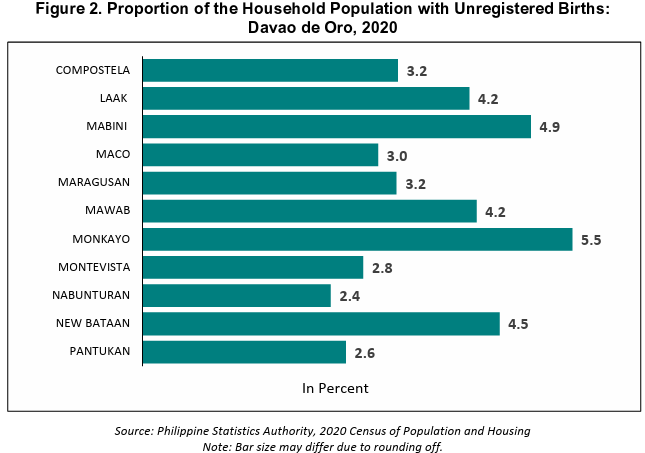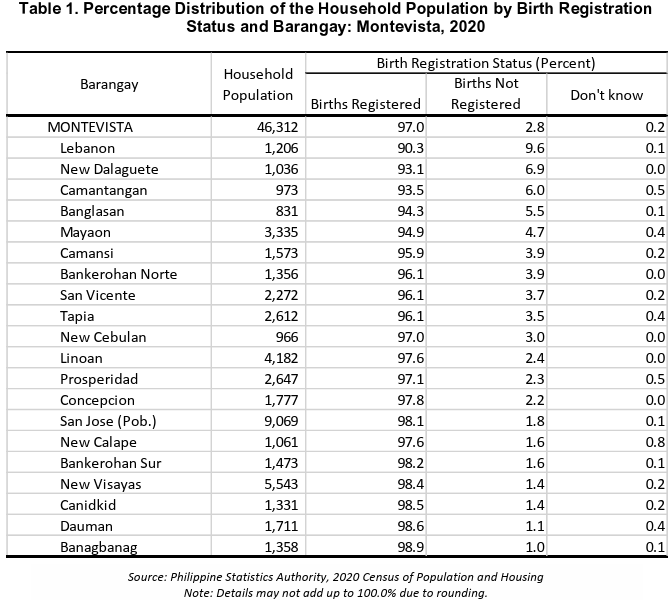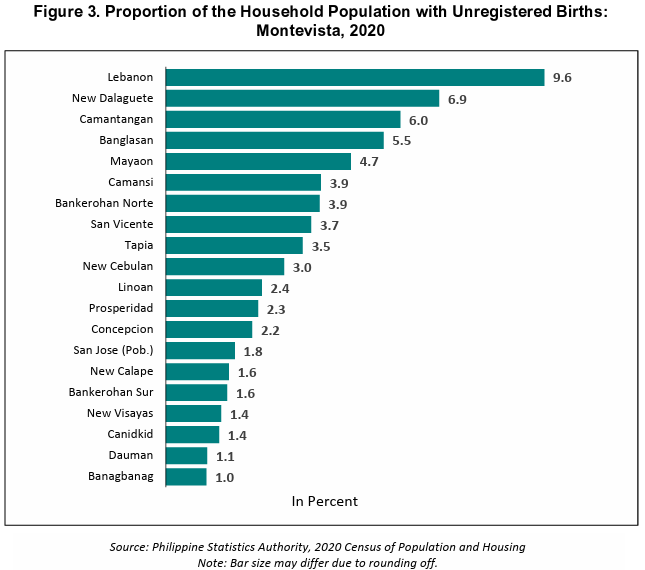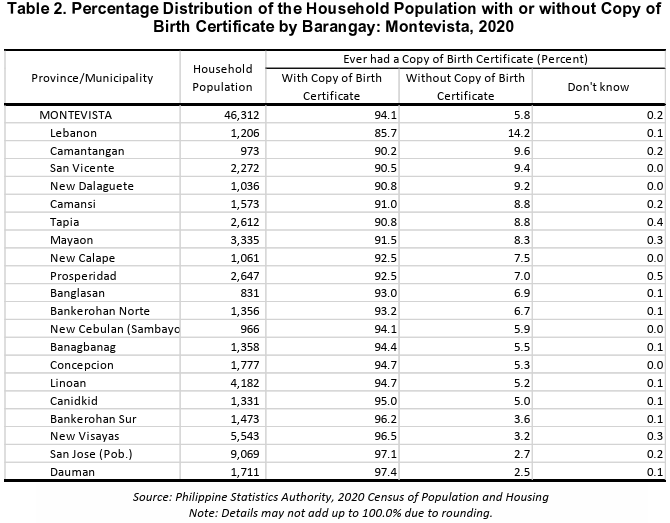Proportion of persons with unregistered births in Montevista increases to 2.8 percent
The 2020 Census of Population and Housing (2020 CPH) revealed that a total of 1,298 persons of the household population in 2020 had their births unregistered with the Local Civil Registry Office (LCRO) of Montevista. This is equivalent to 2.8 percent of the 46,312 household population in 2020. (Figure 1)
Moreover, census results from 2015 to 2020 show an increasing trend in the proportion of persons with unregistered births, from 2.7 percent to 2.8 percent in 2020. The 2020 figure is higher by 0.1 percentage point. (Figure 1)

Montevista is 3rd lowest in the proportion of persons with unregistered births
In 2020, Davao de Oro reported a 3.6 percent of the household population whose births were unregistered with the LCROs. At the municipal level, Monkayo posted the highest with 5.5 percent of the household population. This was followed by Mabini with 4.9 percent and New Bataan with 4.5 percent. Two other municipalities posted a proportion higher than the provincial level, namely, Laak and Mawab. (Figure 2)
Meanwhile, Montevista recorded a proportion of 2.8 percent and ranked 3rd in the province with the lowest proportion of persons with unregistered births. (Figure 2)

On the other hand, Nabunturan posted the lowest proportion of persons with unregistered births (2.4%), followed by Pantukan (2.6%), Montevista (2.8%) and Maco (3.0%). (Figure 2)
Proportion of persons with unregistered births is highest in Lebanon; lowest in Banagbanag
Among the 20 barangays, Lebanon posted the highest proportion of the household population whose births were reported to be unregistered at 9.6 percent, corresponding to 116 persons out of the 1,206 household population in the barangay. It was followed by New Dalaguete with 6.9 percent (72 persons) and Camantangan with 6.0 percent (58 persons). (Table 1 and Figure 3)

Meanwhile, Banagbanag recorded the lowest proportion of unregistered births at 1.0 percent, followed by Dauman (1.1%), and Canidkid and New Visayas (both at 1.4%). (Table 1 and Figure 3)

More females than males have unregistered births
Among the 1,298 household population whose births were unregistered with the LCRO, 49.3 percent (640) were males, while 50.7 percent (658) were females. This translates to a sex ratio of 97 males whose births were unregistered with the LCRO for every 100 females whose births were also unregistered. (Figure 4)

At the barangay level, Lebanon which had the highest proportion whose births were unregistered with the LCRO, on the other hand, showed a higher percentage of males at 52.6 percent compared to females at 47.4 percent.
The oldest age groups post the highest proportions of unregistered births
Across age groups, the household population aged 80 years old and over had the highest proportion of unregistered births at 24.5 percent. The high proportion was also noted in the age group 75-79 years (18.8%), followed by those in the age groups 70-74 years (12.8%), 65-69 years (11.4%), and 60-64 years (9.1%). In contrast, the lowest proportion was recorded in the age group 10-14 at 0.7 percent (Figure 5)

In addition, about 13.0 percent or 503 persons out of 3,883 aged 60 years and above were reported in the census to have unregistered births. This means that 13 in 100 senior citizens have unregistered births. (Figure 5)
Lebanon posts the highest proportion of persons who never had a copy of their birth certificates
While 2.8 percent of the household population reported that their births were unregistered, about 5.8 percent reported that they never had a copy of their birth certificates. A total of 2,663 persons of the 46,312 household population were reported to never had a copy of their birth certificates. (Table 2 and Figure 6)

Among the 24 barangays, Lebanon recorded the highest proportion of household population who never had a copy of their birth certificates, 14.2 percent or 171 persons. It was followed by Camantangan (9.6%), San Vicente (9.4%), and New Dalaguete (9.2%). (Table 2 and Figure 6)
Dauman posted the lowest proportion of persons who never had a copy of their birth certificates at 2.5 percent, followed by San Jose (Poblacion) (2.7%) and New Visayas at 3.2 percent. (Table 2 and Figure 6)

TECHNICAL NOTES
The statistics presented in this Special Release were based on the answers and information provided by the respondent or any responsible member of the household to the questions on birth registration about all the household members. For the 2020 CPH, birth registration data of all household members were collected by asking the respondents, “Was ______’s birth registered with the Local Civil Registry Office?” and “Has _____ ever had a copy of his/her birth certificate?”
